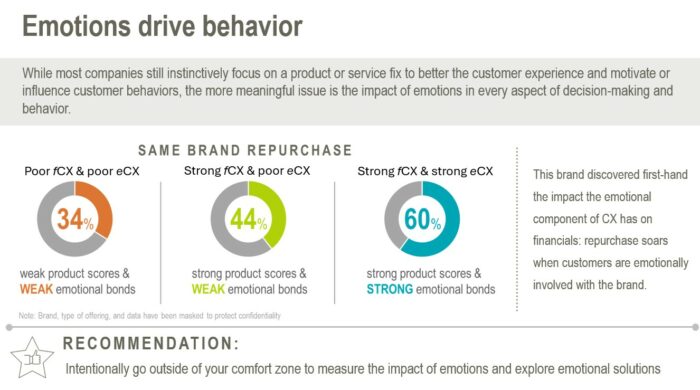
Transactions and relationships are intrinsically interrelated but are inherently different. Measuring and managing both makes sense. What’s more important and companies typically fail to gauge, however, is distinguishing between functional or fCX and emotional or eCX. Instead of muddying the waters by ignoring the distinction, it’s time to recognize the difference between the customer’s perceptions of the functional characteristics of a company’s product or service and the customer’s sense of involvement with or emotional attachment to the brand.
fCX and eCX
Companies sell stuff. It’s only natural that they focus on how their customers evaluate their stuff and the stuff of competitors: quality, speed, price, taste, warmth, ease of use, footprint, reliability — whatever the relevant aspects are for their product/service lines. Most firms have this type of product management mentality and think that the key to improving the customer experience is improving their product or service. When they want to improve the customer experience, they focus on making their products/services better in some manner.
In a world of widespread commoditization, fast-follower copycats, and generic versions of everything, however, product/service differentiation is increasingly difficult. But the product management mindset prevails and continues to dominate, maintaining a focus on improving the company’s stuff as the key.
Sure, every firm’s stuff must be competitive; I am not suggesting that any firm not strive to improve their products and services.
What I am saying is that in study after study (after study) the data indicates that marginal improvements in product/service improvement have little effect on the customer experience. But roll in the emotional dimension, and the impact on measures of CX jump dramatically. In multiple studies I have seen a 50% (yes, fifty percent!) boost in the companies’ CX scores when customers express strong emotional connections. In other words, it is the ability to engage customers and build an emotional attachment that is the key to ratcheting up CX.
Why Emotions Matter
For an experience or interaction to have more than a transitory impact on a customer, the customer must remember what happened. If we don’t remember it, it might as well have never happened and has zero impact on our subsequent perceptions and behavior. People remember, however, only a small fraction of the myriad interactions they have every day, as most are fleeting and dissipate into the ether. To be memorable, to leave an imprint on us, an experience must have an emotional dimension. Emotional involvement makes an experience memorable and gives it a lasting impact on future perceptions and behavior; interactions or experiences with no emotional residue matter for the moment . . . and then are gone.
Customer relationships – the bedrock upon which ongoing loyal behaviors depend — are largely dependent upon emotional connections. The functional performance dimensions need to be present, but functional excellence is table stakes and expected; what differentiates is the emotional bond. Samsung Droids outperform Apple iPhones on functional parameters every day of the week, but Samsung can only dream of nurturing the emotional connection Apple relishes with its devoted customer base.
Transactions are typically dominated by functional performance issues. Did the application work as expected? Was my what-ever-it-is serviced correctly? Was it easy to pay my bill/enter the information/complete the transaction? Many transactions are designed to minimize customer engagement. Ironically, the zero-friction transaction might be the pinnacle of ease that the customer desires, but also leaves little or no residual impact.
But even transactional experiences can have an emotional impact, especially if there is human interaction. Does the customer feel that the employees with whom they interact care about the customer’s concerns or do they see a strictly functional quid pro quo? In one study of auto repairs conducted by dealers, we found a substantial impact from emotional engagement: among those customers who considered the quality of work very good or excellent, those who expressed some emotional involvement in the service experience scored 50% higher in their overall loyalty to the brand than customers who rated the work similarly but felt no emotional involvement.
Emotional CX
It’s time for companies to focus on measuring and building the emotional dimension of the customer experience. Measuring emotions is best accomplished by analyzing unstructured text from customers using emotion analytics. Closed-end questions are counterintuitive for exploring emotions, and relying on the analysis of facial expressions has been debunked. (And please don’t simply hide behind NPS and pretend that NPS captures emotions.) Whether the source is survey open ends, focus group or in-depth interview responses, social media, call center transcripts, or other sources, emotion analytics (a specialized domain within text analytics) can identify the underlying emotions customers are expressing in their words.

Cultivating emotional bonds and designing memorable experiences requires moving beyond the product management focus on the stuff the company sells and looking at the how, where, and why the firm interacts with whom when they engage with customers. In broad strokes, start thinking about what your company can do along these lines.
- Know your customers so you can personalize, stay relevant, and, most importantly, relate to them.
- Stimulate the senses.
- Instill some fun.
- Be nostalgic (that is, connect new memories to old memories).
- Express empathy and concern.
- Surprise customers.
- Keep in mind the peak/end rule (the peak or highlight and end of an interaction are the most memorable).
- Under promise, but over deliver.
How does a company do these things? There is no single answer, of course. You can brainstorm ideas, “borrow” approaches used by other firms, ask customers, or involve employees.
While all of these approaches are worthwhile, employees are the goldmine. Employees, after all, are the customer experience delivery system. Use crowdsourcing (in this case, employee sourcing) tools to involve as many employees as possible (which is a plus in its own right) in generating and curating ideas on “how to . . .” Who else is better positioned to have ideas on how to build such emotional connections?
The product manager types will roll their eyes. Many CX folks will be hesitant to take the risk. Senior leadership may be skeptical. But it’s time that companies moved beyond the pure functional performance hamster wheel and realized that fCX is insufficient and take the plunge into eCX.



